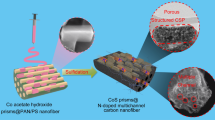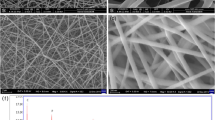Abstract
Core–shell-structured hollow carbon nanofiber@nitrogen-doped porous carbon (HCNF@NPC) composite materials were prepared by carbonization of HCNF@polyaniline. The HCNF@NPC composite materials are applied to the anode for sodium-ion batteries, showing a superior reversible discharge capacity of 182 mAh g−1 after 200 cycles at 50 mA g−1. Moreover, excellent long-term cycling stability (>2500 cycles) is also obtained even at 500 mA g−1. The results indicate that the HCNF@NPC composite electrode shows outstanding electrochemical performance. The excellent performance of HCNF@NPC composite electrode may attribute to the synergetic effect between HCNF core and NPC shell layer, and the HCNF core can provide a firm hollow carbon matrix to stabilize the electrode structure, and the NPC shell layer can improve the capacity effectively.










Similar content being viewed by others
References
Tarascon J, Armand M (2001) Issues and challenges facing rechargeable lithium batteries. Nature 414(6861):359–367
Manthiram A (2011) Materials challenges and opportunities of lithium ion batteries. J Phys Chem Lett 2(3):176–184
Whittingham M (2004) Lithium batteries and cathode materials. Chem Rev 104(10):4271–4302
Slater M, Kim D, Lee E, Johnson C (2013) Sodium-ion batteries. Adv Funct Mater 23(8):947–958
Kim S, Seo D, Ma X, Ceder G, Kang K (2012) Electrode materials for rechargeable sodium-ion batteries: potential alternatives to current lithium-ion batteries. Adv Energy Mater 2(7):710–721
Yabuuchi N, Kajiyama M, Iwatate J, Nishikawa H, Hitomi S (2012) P2-type Nax[Fe1/2Mn1/2]O2 made from earth-abundant elements for rechargeable Na batteries. Nat Mater 11(6):512–517
Stevens D, Dahn J (2001) The mechanisms of lithium and sodium insertion in carbon materials. J Electrochem Soc 148(8):A803–A811
Wang L, Lu Y, Liu J, Xu M, Cheng J (2013) A superior low-cost cathode for a Na-ion battery. Angew Chem 52(7):1964–1967
Luo W, Schardt J, Bommier C, Wang B, Razink J (2013) Carbon nanofibers derived from cellulose nanofibers as a long-life anode material for rechargeable sodium-ion batteries. J Mater Chem A 1:10662–10666
Ponrouch A, Goñi A, Palacín M (2013) High capacity hard carbon anodes for sodium ion batteries in additive free electrolyte. Electrochem Commun 27:85–88
Ding J, Wang H, Li Z, Kohandehghan A, Cui K (2013) Carbon nanosheet frameworks derived from peat moss as high performance sodium ion battery anodes. ACS Nano 7:11004–11015
Li W, Zeng L, Yang Z, Gu L, Wang J (2014) Free-standing and binder free sodium-ion electrodes with ultralong cycle life and high rate performance based on porous carbon nanofibers. Nanoscale 6:693–698
Song H, Li N, Cui H, Wang C (2014) Enhanced storage capability and kinetic processes by pores- and hetero-atoms- riched carbon nanobubbles for lithium-ion and sodium-ion batteries anodes. Nano Energy 4:81–87
Wen Y, He K, Zhu Y, Han F, Xu Y (2014) Expanded graphite as superior anode for sodium-ion batteries. Nat Commun 5:4033. doi:10.1038/ncomms5033
Luo X, Yang C, Peng Y, Pu N, Ger M (2015) Graphene nanosheets, carbon nanotubes, graphite, and activated carbon as anode materials for sodium-ion batteries. J Mater Chem A 3:10320–10326
Wang Z, Qie L, Yuan L, Zhang W, Hu X (2013) Functionalized N-doped interconnected carbon nanofibers as an anode material for sodium-ion storage with excellent performance. Carbon 55:328–334
Wang H, Wu Z, Meng F, Ma D, Huang X (2013) Nitrogen-doped porous carbon nanosheets as low-cost, high-performance anode material for sodium-ion batteries. ChemSusChem 6(1):56–60
Shin W, Jeong H, Kim B, Kang J, Choi J (2012) Nitrogen-doped multiwall carbon nanotubes for lithium storage with extremely high capacity. Nano Lett 12(5):2283–2288
Lota G, Fic K, Frackowiak E (2011) Carbon nanotubes and their composites in electrochemical applications. Energy Environ Sci 4(5):1592–1605
Li Z, Xu Z, Tan X, Wang H, Holt C (2013) Mesoporous nitrogen-rich carbons derived from protein for ultra-high capacity battery anodes and supercapacitors. Energy Environ Sci 6(3):871–878
Fu L, Tang K, Song K, Aken P, Yu Y (2014) Nitrogen doped porous carbon fibres as anode materials for sodium ion batteries with excellent rate performance. Nanoscale 6(3):1384–1389
Li Q, Zhang Z, Guo Z, Lai Y, Zhang K (2014) Improved cyclability of lithium-sulfur battery cathode using encapsulated sulfur in hollow carbon nanofiber@nitrogen-doped porous carbon core-shell composite. Carbon 78:1–9
Chen Y, Li X, Park K, Song J, Hong J, Zhou L, Mai Y, Huang H (2013) Hollow carbon-nanotube/carbon-nanofiber hybrid anodes for Li-ion batteries. J Am Chem Soc 135:16280–16283
Chen Y, Li X, Zhou X, Yao H, Huang H, Mai Y, Zhou L (2014) Hollow-tunneled graphitic carbon nanofibers through Ni-diffusion-induced graphitization as high-performance anode materials. Energy Environ Sci 7:2689–2696
Zhou X, Tang J, Yang J, Xie J, Huang B (2013) Seaweed-like porous carbon from the decomposition of polypyrrole nanowires for application in lithium ion batteries. J Mater Chem A 1:5037–5044
Qie L, Chen W, Wang Z, Shao Q, Li X (2012) Nitrogen-doped porous carbon nanofiber webs as anodes for lithium ion batteries with a super-high capacity and rate capability. Adv Mater 24:2047–2050
Li L, Manthiram A (2014) O- and N- doped carbon nanowebs as metal-free catalysts for hybrid Li-air batteries. Adv Energy Mater. doi:10.1002/aenm.201301795
Wang D, Li F, Yin L, Lu X, Chen Z (2012) Nitrogen-doped carbon monolith for alkaline supercapacitors and understanding nitrogen-induced redox transitions. Chem Eur J 18(17):5345–5351
Xu J, Wang M, Wickramaratne N, Jaroniec M, Dou S (2015) High-performance sodium ion batteries based on a 3D anode from nitrogen-doped graphene foams. Adv Mater 27:2042–2048
Matsumura Y, Wang S, Mondori J (1995) Mechanism leading to irreversible capacity loss in Li ion rechargeable batteries. J Electrochem Soc 142(9):2914–2918
Thomas P, Billaud D (2002) Electrochemical insertion of sodium into hard carbons. Electrochim Acta 47(20):3303–3307
Tang K, Fu L, White R, Yu L, Titirici M (2012) Hollow carbon nanospheres with superior rate capability for sodium-based batteries. Adv Energy Mater 2:873–877
Zhang K, Li X, Liang J, Zhu Y, Hu L (2015) Nitrogen-doped porous interconnected double-shelled hollow carbon spheres with high capacity for lithium ion batteries and sodium ion batteries. Electrochim Acta 155:174–182
Cao Y, Xiao L, Sushko M, Wang W, Schwenzer B (2012) Sodium ion insertion in hollow carbon nanowires for battery applications. Nano Lett 12:3783–3787
Gavrilov N, Pasti I, Vujkovic M, Travas-Sejdic J (2012) High-performance charge storage by N-containing nanostructured carbon derived from polyaniline. Carbon 50:3915–3927
Hou H, Banks C, Jing M, Zhang Y, Ji X (2015) Carbon quantum dots and their derivative 3D porous carbon frameworks for sodium-ion batteries with ultralong cycle life. Adv Mater 27:7861–7866
Acknowledgements
The authors acknowledge the financial support of the Teacher Research Fund of Central South University (2013JSJJ027). This study was supported by grants from the Project of Innovation-driven Plan in Central South University (2015CXS018, 2015CX001).
Author information
Authors and Affiliations
Corresponding author
Rights and permissions
About this article
Cite this article
Qu, Y., Deng, Y., Li, Q. et al. Core–shell-structured hollow carbon nanofiber@nitrogen-doped porous carbon composite materials as anodes for advanced sodium-ion batteries. J Mater Sci 52, 2356–2365 (2017). https://doi.org/10.1007/s10853-016-0528-x
Received:
Accepted:
Published:
Issue Date:
DOI: https://doi.org/10.1007/s10853-016-0528-x




